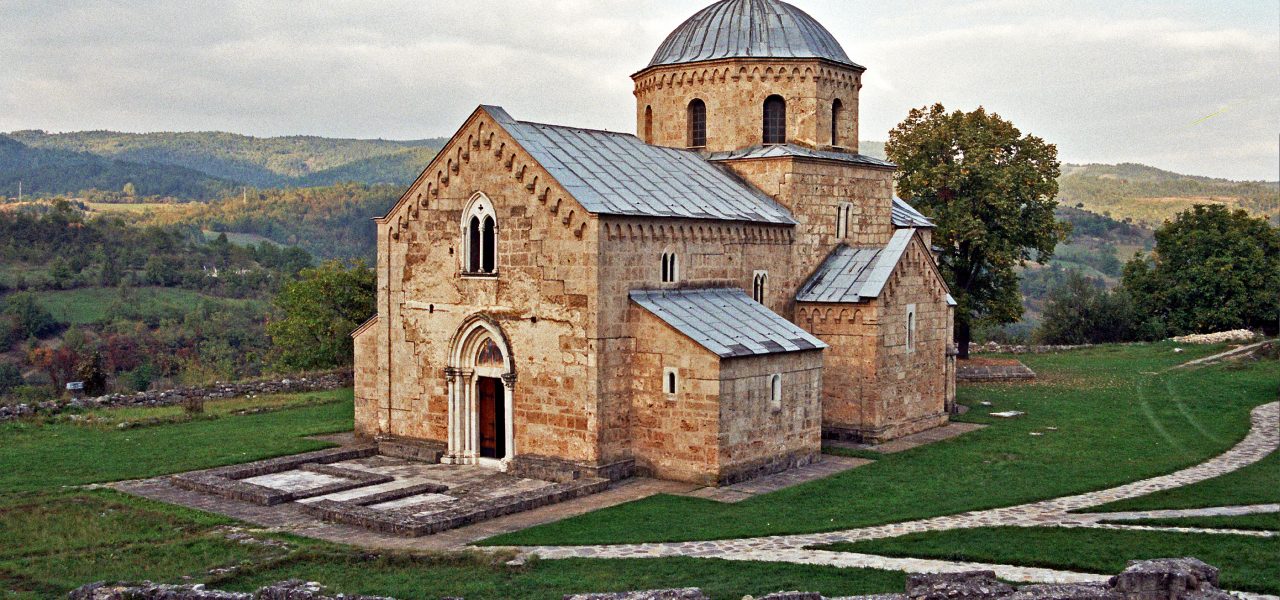INTRODUCTION
Gradac Monastery is a Serbian Orthodox convent located south of Kraljevo in Serbia. It lies on the elevated plateau above the river Gradačka, at the edge of the forested slopes Golija. Gradac Monastery was declared Monument of Culture of Exceptional Importance in 1979, and Serbia protects it. It belongs to the buildings of the Raška school and resembles the monastery Studenica. By using gothic elements, it is, next to the monastery Visoki Dečani, the religious structure most strongly influenced by the western style in Serbia.
HISTORY
Gradac is a foundation and an endowment of Queen Hélène d’Anjou (1237-1314), a French princess and wife of Stefan Uroš I. The monastery was built from 1277 to 1282 on the ruins of an earlier church during the reign of her son king Stefan Dragutin and is also used as the burial place of Queen Hélène and was first girls’ school in medieval Serbia.
Strongly damaged by the Turks after 1389, only fragments of the frescoes are preserved. Gothic elements of windows and portals characterize the building.
ARCHITECTURE AND FURNITURE
The Church of Gradac Monastery is one nave structure with the dome, tripartite altar and rectangle choir, whose central part consists of two chapels, the main naos, and the altar. In the architecture of the shrine of Gradac Monastery that is an example of monumental Serbian-Byzantine style of Raska school of architecture, there are numerous Gothic, Romanesque elements, especially on the portals and on all bifocals, windows divided by a colonnette into two arches. The architectural plastic of the Gradac Monastery carries the properties of the mature and late Romanesque art, like some early Gothic, all being reflected primarily in the finishing of the portal capital, mostly marble framed windows and a series of blind arcades of the roof corona. It was protected by a massive wall and had two entrances. The monastery complex included structures: a large church of the Holy Virgin and the smaller temple of Sv. Nicholas the wonderworker Mirlikijski on the rock above the entrance to the monastery. Of the first dining room, living quarters and the walls that surrounded the monastery complex bases are preserved.
The monastery was devastated at the end of the 14th century. It was partially restored at the end of the 16th century. However, it was finally deserted in the 17th century when the monks, fleeing from the Turks, left somewhere unknown, taking with them the Holy Relics of their founder. In the next 300 years, both churches and the monastery buildings caved in. During the Ottoman rule, the monastery was generally with no monks and no roof cover that was removed from the church. In 1910, a protective roof was placed on a monastery church, and during 1963–1975 a complete reconstruction of the main church was performed by the Institute of the Protection of Cultural monuments of Serbia conducted extensive restoration works on the main Church of the Entry of the Most Holy Theotokos into the Temple and the Chapel of St Nicholas. The fresco decoration of the interior is considerably damaged, but the endower’s composition is still visible, and the original iconostasis is preserved in the first edition. Since 1982 construction of living quarters began and the monastery was revived again. The monastery is a nunnery nowadays.
OPENING HOURS & GUIDED TOURS
April – October:
9am – 7pm
November – March:
from 9am – 6pm
CONTACT
Object
Gradac Monastery
36346 Brevnik
Phone: +381 36 577 8743 or +381 64 800 3884
Mail: mangradac@gmail.com
Website: www.manastirgradac.rs
ENTRANCE FEES
-Free entry-
TOURIST INFORMATION OFFICE
Tourism and Sport Organisation Raska
Nemanjina 1
36350 Raska
Phone: +381 36 738 670 or +381 36 736 085
Mail: office@raska-turizam.rs
Website: www.raska-turizam.rs


